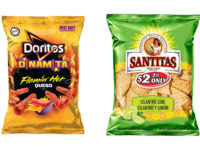The Numbers Game
Hershey likes 60 these days. Lindt tends to go higher — 70, sometimes 85. Others are doing good business with numbers in between — say, 66 or 72. But no matter how high they go, they all must meet the minimum requirement of 43 percent cacao (often termed “cocoa”) to constitute “dark chocolate,” according to European standards, which is having greater influence here as more Americans seek out “richer” chocolate.
As for the United States, the FDA’s standards
and rules for cacao products are highly technical, down to prescribing
analytic techniques and specifying approved processing methods. However,
the standards for sweet (dark) chocolate, as well as for semisweet (or
bittersweet) and milk chocolate, are low compared to American palates these
days. Specifically for dark, the standards are that the chocolate contain
“a minimum of 15 percent chocolate liquor and less than 12 percent
milk solids with varying amounts of sweeteners and cocoa butter.”
So how does that translate to cacao? Cacao and
chocolate liquor are one in the same — they are the “raw
material” cacao beans. Thus, the percentage number on a bar’s
wrapper represents the bar’s weight that actually comes from the
cacao bean. The rest of a chocolate bar is almost entirely sugar, so a
“70 percent” chocolate bar will contain about 30 percent sugar.
The higher the percentage on the wrapper, the lower the percentage of
sugar, and the less sweet, more bitter and complex flavor the bar will be.
So how can would-be dark chocolate connoisseurs choose
their numbers? By taste trial and error is really the only way.
“For those just coming into the dark chocolate
experience, 55-60% is good,” believes Marcia Mogelonsky, senior
research analyst for Mintel International, Chicago. “There’s an
analogy with wine — some people haven’t gotten beyond wine
coolers — those same customers will probably like a lower percentage
of cacao in their chocolate.”


